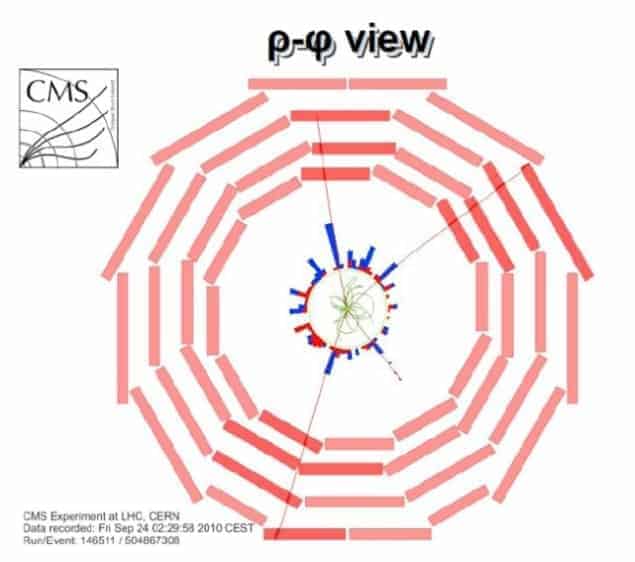
The Large Hadron Collider (LHC) at CERN in Geneva has produced its first pair of Z bosons, based on data released by the compact muon solenoid (CMS) collaboration. Seeing this first pair is an important step in the giant collider’s hunt for the Higgs boson because the generation and analysis of many more such events could provide one of the key signatures of the elusive Higgs.
Believed to provide all particles with mass, the Higgs boson is the last missing piece of the Standard Model of particle physics. The LHC, designed to collide protons into one another at energies of up to 14 TeV, is expected to find the elusive boson – assuming that the Higgs does indeed exist.
Evidence for the Higgs will not come as a single observation. Instead, physicists must accumulate data related to the energy distribution of the particles that the Higgs decays into. One of the cleanest such decay signatures is the transformation of the Higgs into two Z bosons – particles that are one of the carriers of the weak nuclear force. The Z bosons then decay into pairs of heavy charged particles known as muons, which leave an unmistakable footprint in a detector such as CMS.
Layers of particle sensors
Now, the first such event at the LHC has been seen by CMS – one of the collider’s two enormous general-purpose detectors. CMS consists of concentric layers of particle sensors placed inside and around the bore of a 4 T superconducting magnet. Any Z bosons produced by the proton–proton collisions at the centre of the bore are too short-lived to be detected by the surrounding instrumentation. However, the muons last for long enough to travel out from the collision point and traverse all of the detector’s inner sensors. They then travel through a number of gas-filled layers revealing their trajectory via the ionization of this gas. Moving charged particles are bent by a magnetic field such that the curvature of the muons’ paths reveals their momentum.
The CMS data, obtained in the early hours of 24 September, clearly reveal the tracks of four muons (see figure). And the masses of these muons, grouped into two pairs, result in values for the mass of the Z of just over 92 GeV, which is very close to the known Z mass. CMS collaboration member Tommaso Dorigo of the University of Padova in Italy is delighted with the result, describing it on his blog as “as beautiful as they get, or even more so”.
No Higgs required
But Dorigo says that this result on its own provides no evidence that the Higgs boson exists. He points out that pairs of Z bosons can be produced directly by the proton collisions and do not require the intermediate creation of the Higgs. Indeed, he says that this is likely to be the reaction that took place in this case. Showing that the Higgs exists will involve observing many such ZZ pairs and then plotting the distribution of the mass of the pairs. If the pairs are produced in only the direct reaction, then this distribution should be fairly flat; but if instead the Higgs is involved, then the distribution should instead show a peak at a particular value – the mass of the Higgs.
Predicting how many data are likely to be needed to prove that this peak exists, and therefore how long the machine will have to run for before the Higgs is found, is difficult because the fraction of ZZ events that would result from the decay of the Higgs depends on its mass, which is not known from theory. Above about 180 GeV – the combined mass of two Zs – the Higgs can readily decay into a Z-pair, but at lower masses it would be far more likely to decay into other particles that are not so easy to detect.
“For a given Higgs mass we know how many Z pairs, and therefore how many muon quadruplets, we should produce,” says Dorigo. “But since we don’t know the mass, the fraction of muon events that is due to a Higgs could be lower than a tenth or as high as a few tenths.”
Don’t speculate, accumulate
Dorigo is reluctant to speculate on when he and his colleagues might finally bag the Higgs. But in very round terms, he says that about 100 pairs of Zs are likely to be needed, which, he believes, means about 100 times the amount of collision data collected so far. This would be about five times the amount of data that would be accumulated before the collider is due to be switched off for an upgrade to full energy at the end of 2011, meaning that conclusive evidence of a Higgs decay to ZZ pairs before then is unlikely (although other decay signatures might enable a discovery with fewer data).
However, ATLAS team member Andy Parker of Cambridge University in the UK points out that the Fermilab’s Tevatron accelerator in the US could have its lifespan extended to 2014, which might prompt CERN to delay the upgrade for a year. He says that any decision on whether to extend the current run will depend on how well the accelerator performs next year, but he believes that “this year has gone exceptionally well” and that CERN “could still decide to run in 2012”. Either way, he says, the latest CMS result shows that the LHC’s experiments “now have enough data to begin the Higgs search in earnest”.
The work is described in this presentation from the CMS collaboration



